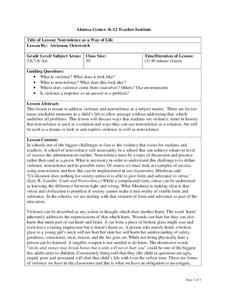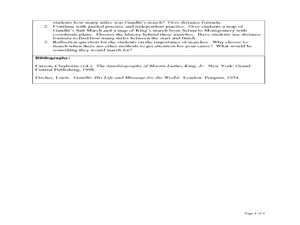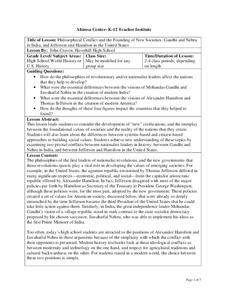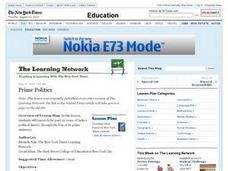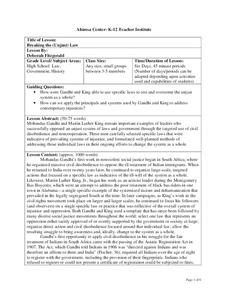Curated OER
Independence Movements: India and Africa
Ninth graders examine the events of the independence movement of India. They listen to a lecture and complete a concept map of the independence movements of the 20th century, watch an excerpt from the movie "Gandhi," and answer...
Curated OER
An Introduction to the Season for Nonviolence
Fourth graders create a Venn diagram and a cause and effect graphic organizer on Gandhi and King. In this non violence lesson plan, 4th graders compare the two non violent leaders and discuss and articulate non violent protests and write...
Curated OER
Actively Organizing Passive Resistance
Students explore organizing to resist oppressive authority without the use of violence. In this philosophy lesson, students research Gandhi's approach to organizing people around a positive cause without the need to be aggressive...
Curated OER
Nonviolence as a Way of Life
Students investigate the example Gandhi set for others to not engage in violence when being oppressed. In this rebellion instructional activity, students identify violence and discuss how it is used and often ineffective....
Curated OER
Satyagraha, Its Origins and Applications
Tenth graders study the steps and methods taken by Gandhi. For this World History lesson, 10th graders create illustrations to represent these steps. Students write a persuasive essay on these measures taken by Gandhi.
Center for Civic Education
Martin Luther King Jr. and the Power of Words
It is easy to forget the power that written or spoken word can have in effecting change. Using quotations from such inspirational leaders as Maya Angelou, Mahatma Gandhi, and Martin Luther King Jr., encourage your class members to...
Curated OER
The Distance Formula and Marching Nonviolently for Social Change
Students explore the distance formula using real world data from nonviolent marches for social change. In this secondary mathematics lesson, students investigate the marches of Gandhi and King using maps overlaid with a coordinate...
Curated OER
Classroom Management Using Gandhian and Kingian Principles of Nonviolence
Tenth graders study the concept of civil disobedience. In this Current Events lesson, 10th graders participate in a survey that nominates students for hard work and exemplifies nonviolence.
Curated OER
The Power of Our Words: Using Language that Promotes Nonviolence
Students solve conflicts through nonviolent means. In this problem resolution lesson, students practice solving problems in different social settings. They try many nonviolent phrases and they create their own solutions.
Curated OER
Philosophical Conflict and the Founding of New Societies: Gandhi and Nehru in India, and Jefferson and Hamilton in the United States
Students explore the foundations of "new societies" such as those created by figures like Jefferson & Ghandi, The evaluate the differences between what was intended and the actual reality of these societies including where the...
Curated OER
Take a Walk in Their Shoes: Great Leaders of Our Time
Research the characteristics of leaders who have used nonviolence to change society. The class then applies this information to their own community to find leaders with these same characteristics, creating a wall collage of pictures and...
PBS
Martin Luther King Jr.: Civil Rights Leader
Expand class members' appreciation of the work of Dr. Martin Luther King, Jr. A powerful resource examines King's speeches, writings, and actions that reveal his deep commitment to a nonviolent approach to Civil Rights. Learners watch a...
Curated OER
Achieving Belonging for All
Students explore ways of belonging. In this social science lesson, students discover non-violent ways for belonging similar to Mohandas Gandhi.
Curated OER
Ahimsa in the Real World: Truth, Love, and Nonviolence
Second graders create an abstract painting that conveys feelings of nonviolence. In this visual arts lesson, 2nd graders read "The First Step of Jainism" and discuss honesty, watch a digital story, discuss feelings after watching...
Curated OER
Prime Politics
Students read Gandhi Says She 'Must Humbly Decline' to be India's Premier from The New York Times and discuss Sonia Ghandi's electoral victory and her response. Students then break into groups and research the past 50 years of India's...
Curated OER
Freedom Now
Students watch a short video on colonial rule. They discuss how lives were changed once independence was granted in India. They create mock interview sessions acting as political figures involved in an independence movement. They...
Curated OER
Culture Creation vs. Culture Consumption - Finding Voice Through Digital Storytelling
Ninth graders explore the power of media in culture and Gandhi's philosophy of nonviolence. In this nonviolence and media instructional activity, 9th graders analyze Gandhi's nonviolent methods for social change and discuss the media's...
Curated OER
Committing to Nonviolence: A Lesson from Viva La Causa
Students examine the social change movements of the American 20th century. In this nonviolence lesson, students research the work of Mahatma Gandhi, Martin Luther King, Jr., and Caesar Chavez. Students compare and contrast the social...
Curated OER
Breaking the Unjust Law
Students consider the concept of civil disobedience. For this lesson on changing unjust laws, students use primary sources to understand how Gandhi and King changed the law. Students will then list laws that they feel are unjust and plan...
Curated OER
Non-violent Protest Through The Ages
Students are introduced to non-violent ways to solve disagreements with others. In groups, they analyze the ways Martin Luther King, Gandhi and Thoreau shared their views in non-violent ways. They complete a sketch of the life of each...
Curated OER
Aahimsa in the Real World: Identifying Ahimsa
Second graders become familiar with the use of the newspaper and how it educates people. In this ahimsa lesson, 2nd graders recognize the importance of Gandhi and his beliefs. Students read articles and answer questions about ahimsa.
Curated OER
Individual Empowerment in the Face of Oppression
Sixth graders investigate non-violent ways of dealing with conflicts by performing short plays. In this philosophy instructional activity, 6th graders discuss how men can gain power in a non-violent manner similar to Gandhi's...
Curated OER
Youth Participation in Nonviolence
Students explore the use of nonviolent resistance. For this social justice lesson, students listen to their instructor present a lecture on Mohandas Gandhi and Martin Luther King, Jr. as well as the Apartheid Movement in South Africa.
Curated OER
Truth and love by Ghandi and King: Experimenting with Satyagraha
Students research Ghandi's philosophy of Satyagraha. In this Satyagraha lesson, students see how Martin Luther King incorporated Ghandi's "truth-force" philosophy into the Black Freedom Movement. They see how this philosophy is present...
Other popular searches
- Mahatma Gandhi
- Nonviolence Gandhi
- Gandhi Movie
- Mohandas Gandhi
- Gandhi and India
- Mahatma Gandhi Salt March
- Gandhi Lesson
- Gandhi Civil Disobedience
- Biography Gandhi
- Mahatma Gandhi the Movie
- Sum Gandhi
- Mahatma Gandhi in Hindi



